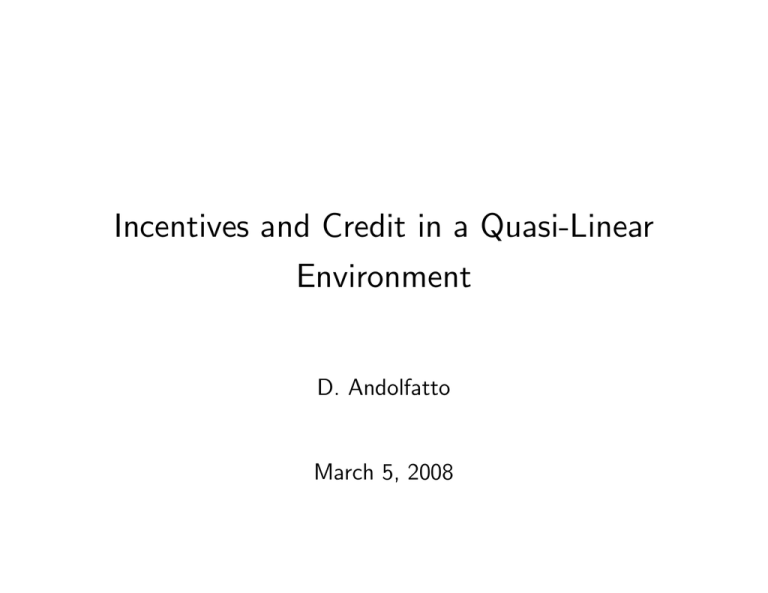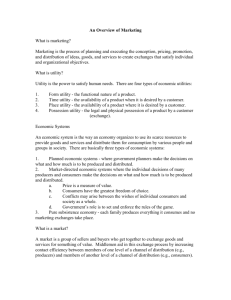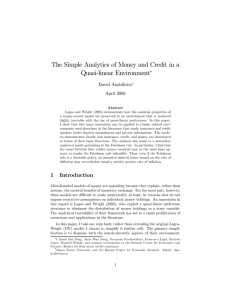Incentives and Credit in a Quasi-Linear Environment D. Andolfatto March 5, 2008
advertisement

Incentives and Credit in a Quasi-Linear
Environment
D. Andolfatto
March 5, 2008
1
The Physical Environment
• Consider an economy consisting of many people (a continuum).
• These people are identical ex ante; but may differ ex post.
• Denote an individual by i ∈ [0, 1].
• Time is discrete and the horizon is infinite; t = 0, 1, 2, ..., ∞.
• Each time period is divided into two subperiods; labelled day and night.
1.1
Day Subperiod
• All agents are in a position to produce or consume goods (utility).
• Let x > 0 denote day consumption and x < 0 denote night production
(transferable utlity).
• This day good is nonstorable; hence, there is an aggregate resource constraint:
Z
xt(i)di = 0;
where xt(i) is consumption at date t by individual i.
1.2
Night Subperiod
• At night, individuals discover either a desire to consume or an ability to
produce.
• This desire/ability (their type) is determined randomly by an exogenous
stochastic process (i.i.d. across people and time).
• Assume (for simplicity) a 50-50 chance of becoming either type.
— If they have a desire to consume, then utility is u(c).
— If they have an ability to produce, then utility is −g(y).
• Note: this stochastic preference/technology shock structure mimics what
would happen with random pairwise meetings (and lack of double coincidence of wants) in a search environment.
• The night good is also nonstorable; hence there is another aggregate resource constraint:
Z
ct(i)di =
Z
yt(i)di;
• where {ct(i), yt(i)} denotes consumption and production at date t by
individual i.
1.3
Preferences
• As people are ex ante identical, their preferences can be represented as:
∞
X
½
µ ¶
¾
1
t
β xt(i) +
[u(ct(i)) − g(yt(i))] .
E0
2
t=0
• where 0 < β < 1 (note that there is no discounting across subperiods).
2
The First-Best Allocation
• Let’s think about this.
• Assume that we weight all agents equally (and why shouldn’t we—they are
ex ante identical).
• Then all agents will receive the same expected (ex ante) utility payoff.
• First question: How should {xt(i)} be allocated across people?
• Note that the resource constraint requires:
Z
xt(i)di = 0.
• One obvious solution is to have xt(i) = 0 for all i and all t.
• In fact, because utility (for all people) is linear in x, there are many other
solutions as well.
• For example:
xt(i) =
(
+x w.p. 1/2;
−x w.p. 1/2;
for any x ∈ R is also a solution.
• Because people are risk-neutral in xt(i), any lottery over xt(i) such that
Etxt(i) = 0 is both feasible and in no way reduces expected utility
(people will, of course, differ ex post).
• Second question: How should {ct(i), yt(i)} be allocated across people?
• Efficiency dictates that ct(i) = 0 if i is a producer (he does not value
consumption).
• Feasibility dictates that yt(i) = 0 if i is a consumer (he does not have an
ability to produce).
• Given the curvature in u and g, it will make sense here to set ct(i) = c
for i who are consumers and yt(i) = y for i who are producers.
• Since there is an equal number of consumers and producers, the resource
constraint implies c = y.
• Hence, with E0xt(i) = 0, ex ante utility for a given y can be expressed
as:
µ ¶
1
(1 − β)−1 [u(y) − g(y)] .
W (y) =
2
• Clearly, the function W is strictly concave and achieves a unique maximum
at y ∗ satisfying u0(y ∗) = g 0(y ∗).
• That is, the planner assigns c∗t (i) = y ∗ and yt∗(i) = 0 if i is a consumer
during the night; and c∗t (i) = 0 and yt∗(i) = y ∗ if i is a producer during
the night.
3
Discussion
• The first-best allocation described above can be thought of as the outcome
of a social credit or social insurance arrangement.
• As an insurance arrangement, you can think of producers as paying a net
premium y ∗ and consumers receiving a net benefit y ∗.
• As a credit arrangement, you can think of consumers borrowing y ∗ from
society in exchange for the promise to produce y ∗ at some time in the
future (when they have an ability to produce).
• If there was a social planner (benevolent, of course) who was all-powerful
in the sense of being able to observe types and enforce allocations, then
the resource allocation problem is easily solved:
From each according to his ability; To each according to his need.
• The same good outcome can be achieved if all people behaved cooperatively; i.e., in the sense of always honoring their promises (debt obligations)
and always reporting their types truthfully.
• Moreover, note that if agents can commit to honor their promises (debt
obligations) and if types are publicly observable, then the standard welfare
theorems would appear to apply.
• That is, the first-best allocation is implementable as a competitive equilibrium (there are potentially many market structures that could achieve
this).
• Consider, for example, a competitive insurance market. Prior to realization of personal shocks, agents can issue promises to deliver output y ∗
contingent on being a producer.
• They can then use the value of these promises to purchase consumption
insurance (allowing them to consume y ∗ in the event that they have a
desire to consume).
• In short, this is a boring world (reminds me of Canada)...so let’s spice
things up a bit.
4
Private Information
• Imagine that types are private information; but that agents can commit
(not to telling the truth, of course).
• In this case, an allocation will have to be made contingent on reports of
types.
• In fact, in a dynamic setting, it is generally desirable to make an allocation
contingent on the agent’s entire personal history of reports and actions.
• As it turns out, our quasi-linear environment simplifies matters greatly; i.e.,
we may without loss condition allocations on an agent’s personal history
going back one period only.
• Key Point: Some memory will be essential (although limited memory
suffices in a quasi-linear environment).
— Memory: a public-access database of personal histories (Kocherlakota,
1998);
— requires that people are identifiable by their personal histories (i.e.,
they are not anonymous).
• We can then appeal to the Revelation Principle: Any constrained-efficient
allocation can be implemented as the equilibrium of a direct revelation
game in which people (strategically) report their types truthfully.
• Let’s see how this might work...
• Let me focus on (stationary) allocations of the form (x, y), where:
xt(i) =
(
+x if (ct−1(i), yt−1(i)) = (0, y);
−x if (ct−1(i), yt−1(i)) = (y, 0);
with x0(i) = 0 for all i.
• Observe that this allocation embeds within it a punishment-reward system (those who produced in the last period are rewarded today; and those
who consumed in the last period are punished today)—similar to a credit
market (producers are savers and consumers are borrowers).
• Note that, under truthtelling, any such allocation is feasible and generates
the welfare function:
µ ¶
1
W (y) =
(1 − β)−1 [u(y) − g(y)] .
2
• To induce truth-telling behavior, the allocation must be incentive-compatible
(people must have no incentive to misreport their type).
• In this setup, it is clear that consumers cannot pretend to be producers
(i.e., they have no ability to produce).
• However, producers may have an incentive to pretend to be consumers
(i.e., they can economize on the disutility of production).
• Hence, the relevant incentive-compatibility (IC) condition is given by:
or
−g(y) + β [x + W (y)] ≥ 0 + β [−x + W (y)] ;
x≥
Ã
!
1
g(y).
2β
• In words, the IC condition says that to get producers to reveal themselves
as such, they need to be compensated with a sufficiently large future reward
x.
Since there is no upper bound on x here, the first-best allocation is clearly
implementable; i.e., simply choose any x such that:
x≥
Ã
!
1
g(y ∗).
2β
• Note that this x is supplied in the next day by those people who consumed
(borrowed) the previous night.
• Our assumption of commitment here implies that this debt will be honored,
regardless of the size of x.
5
Limited Commitment
• What if individuals cannot be expected to automatically honor their debt
obligations?
• If individuals could renege on their debt with impunity, then the only implementable allocation here is autarky.
• To encourage voluntary debt repayment, debtors must be threatened with
some credible punishment for noncompliance.
• Generally, the harshest punishment (or penal code) available is to be
preferred.
• Absent overt coercion, the harshest punishment for noncompliance is the
threat of perpetual banishment to autarky.
• Note that as each agent is of measure zero, the banishment of any countable number of agents will have no impact on aggregates (so that the
threat of banishment is legitimately credible).
• Moreover, this punishment is feasible because agents are (by assumption)
identifiable.
• Let W (0) = 0 denote the payoff associated with autarky.
• The lack of commitment implies that the allocation (x, y) must also satisfy
a set of sequential participation constraints (also called sequential or
ex post individual rationality constraints).
• The potentially binding SP constaint here is with respect to the person in
the day who is obliged to repay the debt x (this person was a consumer in
the previous night); i.e.,
−x + W (y) ≥ 0;
or
x ≤ W (y).
• In words, the maximum amount of debt that will be voluntarily repaid is
bounded above by the value of continued participation in the social credit
arrangement.
• Together, the IC and SP constraints restrict the set of implementable
allocations (x, y) to the set:
Ã
!
1
g(y) ≤ x ≤ W (y).
2β
Proposition 1 Define β 0 ≡ g(y ∗)/u(y ∗). Then the first-best allocation is
implementable for any β ∈ [β 0, 1).
Proposition 2 For any β ∈ [0, β 0), the constrained-efficient (second-best)
allocation is characterized by 0 ≤ y0 < y ∗ satisfying:
Ã
!
1
g(y0) = W (y0);
2β
or
g(y0) = βu(y0).








